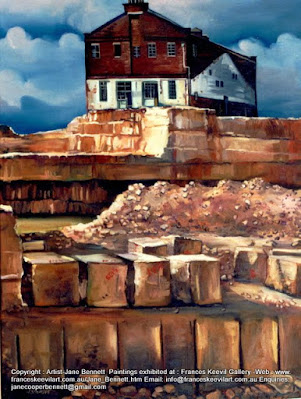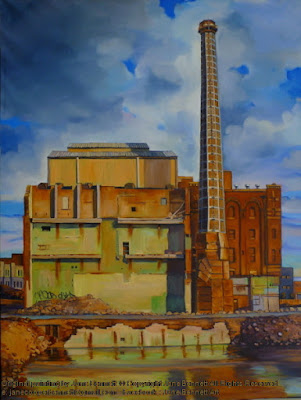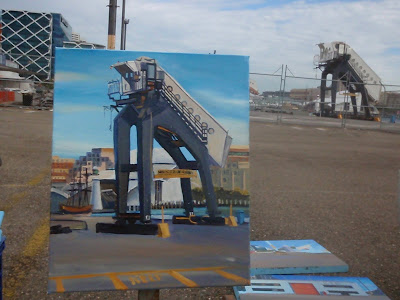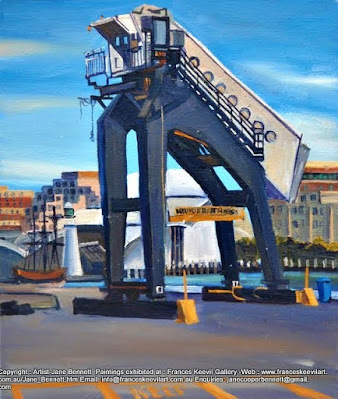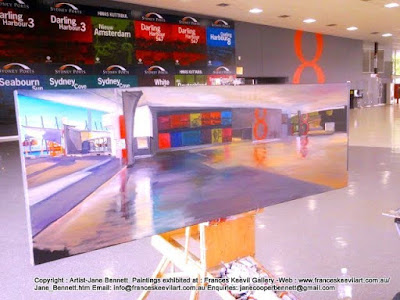The 198m stack was built in 1965 on the Port Kembla Copper smelter site, off Electrolytic Road between Military Road and Darcy Road.
The Port Kembla Copper smelter finally closed down in 2003. Despite PKC’s efforts to keep the site open as a tourist attraction, an application was made to have it demolished in 2010.
This application then suffered a lengthy delay when asbestos was discovered at the site. There were a few false alarms - there was a rumour that it would be demolished in April 2013, then again in September. I realised that this time it would actually happen and I hurried down there 2 days before to try to paint the stack from as many vantage points as possible.
Better late than never!
I made sure that I packed a lot of long skinny canvases.
This application then suffered a lengthy delay when asbestos was discovered at the site. There were a few false alarms - there was a rumour that it would be demolished in April 2013, then again in September. I realised that this time it would actually happen and I hurried down there 2 days before to try to paint the stack from as many vantage points as possible.
Better late than never!
I made sure that I packed a lot of long skinny canvases.
 |
Starting an oil painting of the 2 chimneys of Port Kembla Copper on Tuesday evening 18th February 2014
|
When I arrived on Tuesday afternoon, I started painting the stack from just outside the fence around the ruins of Port Kembla Copper on Darcy Road at the former Gate 18.
There was an earlier brick chimney, built probably in the early 1900s, which I believe might be retained. I wanted to capture the two together in my painting, although I wasn't able to include it in this photo.
I managed to complete a small canvas (31 x 15cm) of the copper stack from Darcy Road. I was rushing to paint as much as I could before the light faded, so I didn't stop to take a photo of this in situ, but you can see it in the photo below, in front of the blank canvas.
It is a poignant image of the stack behind the ruined tanks, furnaces and the old gatehouse of Port Kembla Copper against the luminous evening clouds.
There was an earlier brick chimney, built probably in the early 1900s, which I believe might be retained. I wanted to capture the two together in my painting, although I wasn't able to include it in this photo.
I managed to complete a small canvas (31 x 15cm) of the copper stack from Darcy Road. I was rushing to paint as much as I could before the light faded, so I didn't stop to take a photo of this in situ, but you can see it in the photo below, in front of the blank canvas.
It is a poignant image of the stack behind the ruined tanks, furnaces and the old gatehouse of Port Kembla Copper against the luminous evening clouds.
 |
| Starting an oil painting of the Port Kembla Copper stack from Military Road on Wednesday morning 19th February 2014 Available |
Early on Wednesday morning I set up my easel at the top of Military Road, next to Hill 60.
I put the small canvas of the stack from Darcy Road against my easel as inspiration.
As a 300m exclusion zone around the area was to be set up on Thursday, I had spent most of the previous day wandering around Port Kembla looking for good vantage points to paint and to view the demolition. The dramatic perspective of the hill and road leading up to the stack made this spot the winner.

Starting a painting of the Port Kembla Copper stack
from Military Road on Wednesday morning 19th February 2014
"Port Kembla Copper stack from Military Road,
the last day before demolition"
oil on canvas 61 x 31cm
Available
The sullen clouds overhead were joined by the smoke from the still operational Port Kembla Steelworks in the middle distance. Their chimneys were humbled by the overpowering height and bulk of the iconic Copper Stack.
Rumours about the impending closure of the steelworks made this scene even more poignant.
I wasn't the only one to find this great view.
As a 300m exclusion zone around the area was to be set up on Thursday, I had spent most of the previous day wandering around Port Kembla looking for good vantage points to paint and to view the demolition. The dramatic perspective of the hill and road leading up to the stack made this spot the winner.

Starting a painting of the Port Kembla Copper stack
from Military Road on Wednesday morning 19th February 2014
"Port Kembla Copper stack from Military Road,
the last day before demolition"
oil on canvas 61 x 31cm
Available
The sullen clouds overhead were joined by the smoke from the still operational Port Kembla Steelworks in the middle distance. Their chimneys were humbled by the overpowering height and bulk of the iconic Copper Stack.
Rumours about the impending closure of the steelworks made this scene even more poignant.
I wasn't the only one to find this great view.
As you can see by the camera on the tripod in the photo above, I had barely started to paint when tag teams of roaming journalists descended to interview the local residents.

Starting a painting of the Port Kembla Copper stack
from Military Road on Wednesday morning 19th February 2014
"Port Kembla Copper stack from Military Road,
the last day before demolition"
oil on canvas 61 x 31cm
Available

Starting a painting of the Port Kembla Copper stack
from Military Road on Wednesday morning 19th February 2014
"Port Kembla Copper stack from Military Road,
the last day before demolition"
oil on canvas 61 x 31cm
Available
I received a fair share of the media attention as well.
"Painting an iconic landscape before a looming monolith is felled" by Justin Huntsdale 19 February, 2014 3:00PM ABC Illawarra

Painting of the Port Kembla Copper stack
from Military Road on Wednesday morning 19th February 2014
"Port Kembla Copper stack from Military Road,
the last day before demolition"
oil on canvas 61 x 31cm
Available
"Painting an iconic landscape before a looming monolith is felled" by Justin Huntsdale 19 February, 2014 3:00PM ABC Illawarra

Painting of the Port Kembla Copper stack
from Military Road on Wednesday morning 19th February 2014
"Port Kembla Copper stack from Military Road,
the last day before demolition"
oil on canvas 61 x 31cm
Available
However, by noon it had started to cloud over and I was worried that the distractions would mean that I wouldn't be able to complete my canvas before the rain became too heavy to continue.

Painting of the Port Kembla Copper stack
from Military Road on Wednesday morning 19th February 2014
"Port Kembla Copper stack from Military Road,
the last day before demolition"
oil on canvas 61 x 31cm
Available

Painting of the Port Kembla Copper stack
from Military Road on Wednesday morning 19th February 2014
"Port Kembla Copper stack from Military Road,
the last day before demolition"
oil on canvas 61 x 31cm
Available
By 2pm I had to leave as I was drenched, however, I had managed to capture the last day of the Port Kembla Copper Stack.
Related posts
by Justin Huntsdale
19 February, 2014 3:00PM ABC Illawarra
19 February, 2014 3:00PM ABC Illawarra





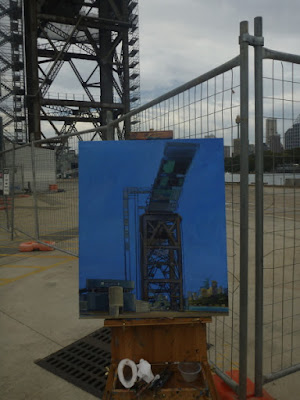
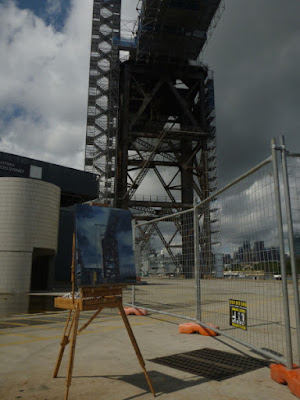
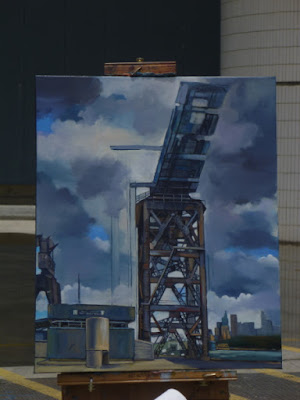


.jpg)
.jpg)
.jpg)
.jpg)
.jpg)
.jpg)
.jpg)
.jpg)


